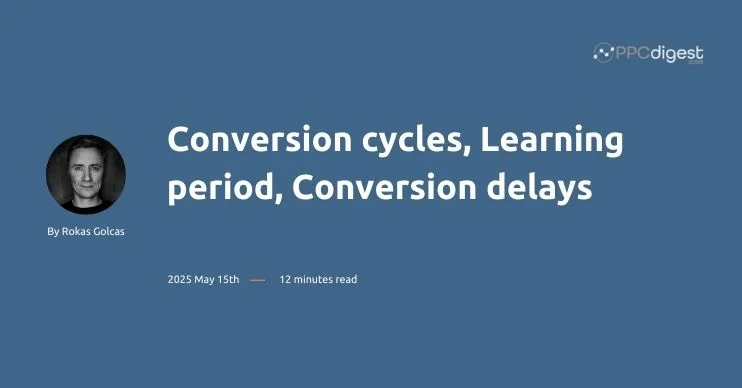
Your campaigns might be working—but the results don’t show it yet.
Between the click and the conversion, time distorts performance. Delayed data, bidding adjustments, and shifting strategy all play a part. And if you don’t account for them, you’re optimizing in the dark.
Here’s what you need to know about conversion cycles, learning periods, and the reporting lag that could be misleading your next move.
Conversion Cycle
A conversion cycle is the time between a click and when a conversion occurs and is reported in Google Ads. If you’re importing conversions, this cycle also includes the time lag in reporting.
Impacts on Campaign Performance & Optimization
1. Delayed Performance Signals
Automated bidding strategies (like Maximize Conversions or Target CPA) rely on recent performance data.
If your conversion cycle is long (e.g., 5–7 days), Google may not immediately see which clicks converted.
This causes under-reporting of conversions in the short term → system might overcompensate or underbid until more data is available.
2. Longer Learning Periods
Smart Bidding needs to see conversion data to optimize effectively.
A longer conversion cycle means more time needed for 50 conversions or 3 full cycles → extends the Learning period.
3. Skewed ROAS & CPA in Early Reporting
Right after launch or major changes, performance metrics (CPA, ROAS) may look worse than they are.
Marketers might pause or adjust campaigns prematurely without realizing that conversions are still in progress.
4. Bid Strategy Adjustments
Google’s bid strategies try to predict future conversions using historical cycle data.
In the bid strategy report, Google may show “expected additional conversions” still pending — so you shouldn’t evaluate performance too early.
What Advertisers Should Do About It:
- Give campaigns enough time. Wait for full cycle data before evaluating performance
- Avoid frequent changes. Each reset can restart the learning phase, slowing optimization
- Set realistic expectations. Communicate internally or to clients that results will improve over time
Learning Period (Google Ads Definition)
The Learning Period is the time it takes for a Smart Bidding strategy to recalibrate and optimize bids after significant changes are made to your campaign or bidding settings. During this period, your campaign’s performance may be less stable as the system gathers fresh data to adjust toward your goals.
The learning period begins when:
- New strategy: A bid strategy is newly created or reactivated.
- Setting change: A key setting in the bid strategy (like target CPA or ROAS) is changed.
- Composition change: You add/remove campaigns, ad groups, keywords, or product groups.
You’ll see a “Learning” status in the Bid strategy status column during this time. Hovering over it reveals which of the above three reasons is causing it.
What Affects the Duration of the Learning Period
The learning period usually ends when the system has enough data to optimize confidently. It typically takes:
- Around 50 conversion events, or
- About 3 full conversion cycles (e.g., if your average conversion cycle is 2 days, it could take up to 6 days)
However, the time can vary depending on:
- Conversion volume. More conversions = faster learning
- Length of conversion cycle. Longer cycles = longer learning period
- Bid strategy type. Some (e.g., Target CPA/ROAS) need more time/data than others
⚠️ Note: Manual CPC doesn’t have a learning period, as it doesn’t rely on Smart Bidding.
Also, even when the “Learning” label disappears, Google’s algorithm continues refining bids behind the scenes.
Conversion Delay
Conversion delay is the time between a user’s ad click and when that conversion is actually reported in Google Ads. It’s not about when the user converts, but when the platform becomes aware of it — which can be delayed due to import lags, offline data syncing, or attribution settings. This delay can cause short-term underreporting of conversions, which may make CPA or ROAS appear worse than they actually are.
You might think, then, what’s the difference between Conversion delay and Conversion Cycle? And you’re right, they sound similar. Think of it this way:
- Conversion Cycle = “How long it takes for a person to buy.”
- Conversion Delay = “How long it takes for Google to know they bought.”
Google Ads attributes conversions to the date of the ad click (or impression), not the actual date of the conversion. This causes a delay in reporting, especially if users take several hours or days to convert.
- CPA may appear higher immediately after launch because some conversions haven’t been reported yet.
- ROAS may appear lower until all delayed conversions are captured.
- Performance may look worse than it really is in the short term.
In my experience, it might take 24 hours to see conversions in Google Ads. I’ve also seen a delay of only several hours. That’s why I never make decisions until several days have passed.

Blogging gives me a chance to share my extensive experience with Google Ads. I hope you will find my posts useful. I try to write once a week, and you’re welcome to join my newsletter. Or we can connect on LinkedIn.